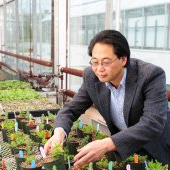You are currently viewing a beta version of our website. If you spot anything unusual, kindly let us know.
Preprint
Article
Increasing Levels of Supplemental Led Light Enhances the Rate Flower Development of Greenhouse-Grown Cut Gerbera but Does Not Affect Flower Size and Quality
Altmetrics
Downloads
140
Views
180
Comments
0
A peer-reviewed article of this preprint also exists.
This version is not peer-reviewed
Abstract
To investigate the influence of supplemental lighting intensity on the production of cut gerbera during Canada’s supplemental lighting season (November to March), trials were carried out at a research greenhouse. Five supplemental LED light intensity (LI) treatments provided canopy-level photosynthetic photon flux densities (PPFD) ranging from 41 to 180 µmol·m-2·s-1. With a 12-h photoperiod, the treatments provided 1.76 to 7.72 mol·m-2·d-1 of supplemental light. Two cultivars of cut gerbera (Gerbera jamesonii H. Bolus ex Hook.f) were used to evaluate vegetative growth and flower production. Plugs of ‘Ultima’ were assessed for vegetative growth and rate of flower development. There were minor LI treatment effects on number of leaves and chlorophyll content index and flowers from plants under the highest vs. lowest LI matured 10% faster. Reproductively mature ‘Panama’ plants were assessed for flower yield and quality. ‘Panama’ flowers from the highest LI treatment had shorter stems than the three lowest LI treatments, flowers from the middle LI treatment had larger diameter than the other treatments. Flowers from the lowest LI treatment had lower fresh mass than the three highest LI treatments. There were linear relationships between LI and numbers of flowers harvested, with the highest LI treatment producing 10.3 and 7.0 more total and marketable flowers per plant than the lowest LI treatment. In general, increasing levels of supplemental light had only minor effects on vegetative growth (young plants) and size and quality of harvested flowers (mature plants) but flowers from plants grown under higher LIs were more numerous and matured faster.
Keywords:
Subject: Biology and Life Sciences - Horticulture
Copyright: This open access article is published under a Creative Commons CC BY 4.0 license, which permit the free download, distribution, and reuse, provided that the author and preprint are cited in any reuse.
Submitted:
13 August 2020
Posted:
17 August 2020
You are already at the latest version
Alerts
A peer-reviewed article of this preprint also exists.
This version is not peer-reviewed
Submitted:
13 August 2020
Posted:
17 August 2020
You are already at the latest version
Alerts
Abstract
To investigate the influence of supplemental lighting intensity on the production of cut gerbera during Canada’s supplemental lighting season (November to March), trials were carried out at a research greenhouse. Five supplemental LED light intensity (LI) treatments provided canopy-level photosynthetic photon flux densities (PPFD) ranging from 41 to 180 µmol·m-2·s-1. With a 12-h photoperiod, the treatments provided 1.76 to 7.72 mol·m-2·d-1 of supplemental light. Two cultivars of cut gerbera (Gerbera jamesonii H. Bolus ex Hook.f) were used to evaluate vegetative growth and flower production. Plugs of ‘Ultima’ were assessed for vegetative growth and rate of flower development. There were minor LI treatment effects on number of leaves and chlorophyll content index and flowers from plants under the highest vs. lowest LI matured 10% faster. Reproductively mature ‘Panama’ plants were assessed for flower yield and quality. ‘Panama’ flowers from the highest LI treatment had shorter stems than the three lowest LI treatments, flowers from the middle LI treatment had larger diameter than the other treatments. Flowers from the lowest LI treatment had lower fresh mass than the three highest LI treatments. There were linear relationships between LI and numbers of flowers harvested, with the highest LI treatment producing 10.3 and 7.0 more total and marketable flowers per plant than the lowest LI treatment. In general, increasing levels of supplemental light had only minor effects on vegetative growth (young plants) and size and quality of harvested flowers (mature plants) but flowers from plants grown under higher LIs were more numerous and matured faster.
Keywords:
Subject: Biology and Life Sciences - Horticulture
Copyright: This open access article is published under a Creative Commons CC BY 4.0 license, which permit the free download, distribution, and reuse, provided that the author and preprint are cited in any reuse.
High Light Intensities Can Be Used to Grow Healthy and Robust Cannabis Plants During the Vegetative Stage of Indoor Production
Melissa Moher
et al.
,
2021
In Vitro Seedlings of Eustoma grandiflorum in Response to LED Light in an Acclimation Environment
Md Zohurul Kadir Roni
et al.
,
2018
MDPI Initiatives
Important Links
© 2024 MDPI (Basel, Switzerland) unless otherwise stated





